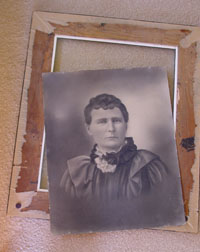Sign up for the Family Tree Newsletter Plus, you’ll receive our 10 Essential Genealogy Research Forms PDF as a special thank you!
Get Your Free Genealogy Forms
"*" indicates required fields
Sometimes things aren’t quite what they appear. Maxine Leonard’s aunt and uncle gave her this picture when she was 5 after she became upset they were moving away. Leonard has treasured the ornate framed illustration of a child in front of a Christmas tree because it reminds her of her cherished aunt. After seeing a TV program on ?pictures behind pictures? Leonard took apart her framed print to see if anything was hidden behind it. To her amazement, a charcoal portrait of a woman was underneath. ?Genealogy is my passion and I really want to know who’s in this picture,? Leonard says. Here are a few tips to help her find out.
Networking
When you’re not sure whether two photographs show the same person, first date the pictures using family facts and clothing details. Since Wooldridge knows the woman the same is in both pictures, dating one of the images should help determine who the men are. Though this is a solvable case, it’s easy to see why there’s confusion.
One way to identify a picture is by showing it to as many people as possible. Leonard’s sister subscribes to the Family Tree Magazine E-Mail Update newsletter, and she suggested Leonard contact me about her mystery photo. Submission guidelines for this column advise emailing a scanned photo or sending the editors a photographic copy—but because Leonard had so many different shots of the same picture I suggested she copy them to a CD and mail that instead. She also included her contact information and her phone number. One rainy day I picked up the phone and called her, eager for more details about her family and this picture.
Provenance
When you stumble upon an unexpected discovery it helps to retrace the history of an object. Museums and collectors call this history of ownership the object’s provenance. Leonard received her image from a paternal aunt. It’s unknown if the aunt was aware of the charcoal portrait behind the picture, but she may have placed it there to reuse the frame. Why wouldn’t she have kept it? Perhaps there was some family animosity. “My aunt married a divorced man and her father disowned her,” says Leonard. Despite being shunned by her family, the aunt ended up with this picture and the family Bible.
Time Frame
A photographer told Leonard the portrait was a charcoal drawing, but it’s actually a photograph enhanced by charcoal. I’ve written about these crayon or charcoal portraits in pat columns—see www.familytreemagazine.com:80/photos/may15-00.htm and www.familytreemagazine.com:80/photos/march29-01.htm. You can also learn more about these types of pictures in Heinz K. Henisch and Bridget A. Henisch’s The Painted Photograph, 1839-1914 (Pennsylvania State University Press, $101.95). Charcoal portraits were particularly popular in the late 19th and early 20th century.
The clothing clues in this picture are very clear. The woman’s very full, puffy upper sleeves date the picture to around 1895.
ID
Leonard’s sure this woman is family, but isn’t sure who she is. She suspects her paternal grandmother Mary (Rusco) Fraser or Great-Grandmother Wealthy (Prescott) Rusco. Several years ago she placed a query in a magazine, but received no promising leads. Now she’s going through her genealogical information for clues.
The next step is to preserve the original. Charcoal portraits are usually rendered on brittle paper backed with canvas, and the charcoal smudges easily, so it’s important take some steps to save this family treasure. She should mat it with an acid- and lignin free mat and backing it with acid and lignin free cardboard before placing it back in the frame, and display it away from direct sunlight.
I’ll update you on Leonard’s progress in identifying this woman. Look for news on other recent mysteries in an upcoming column. <!– 
Helping Hands
–>Although family recollections are usually the best way to identify a photograph, relatives don’t always know who’s pictured. The best way to tell who the men in these photographs are is to locate other images of them for comparison. Based on the evidence I have, I think the man in the portrait of the couple is Myrtle’s father, and the male in the group portrait is her husband.
ADVERTISEMENT


